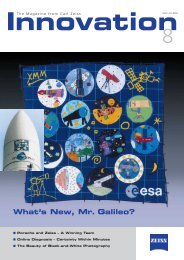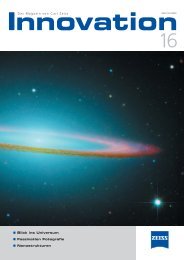Download PDF - Carl Zeiss
Download PDF - Carl Zeiss
Download PDF - Carl Zeiss
Create successful ePaper yourself
Turn your PDF publications into a flip-book with our unique Google optimized e-Paper software.
Entering the<br />
world of astronomy<br />
Binoculars such as the Victory 32 T*<br />
FL and Victory 42 T* FL, as well<br />
as spotting scopes such as the<br />
Diascope 65 T* FL and Diascope 85<br />
T* FL, are ideal for uncomplicated<br />
viewing of the night sky and bring<br />
viewers a good deal closer to the<br />
heavens. Compared to a telescope,<br />
binoculars and spotting scopes are<br />
more versatile: they can be used to<br />
easily observe objects in the bush or<br />
the heavens and can accompany<br />
their owners on vacation without<br />
taking up a lot of space. A suitable<br />
stand is recommended for comfortable,<br />
vibration-free viewing of the<br />
night sky at high magnification.<br />
In addition to optics, a good star<br />
map is required to see heavenly objects<br />
– after all, you have to know<br />
exactly where to look.<br />
Innovation 16, <strong>Carl</strong> <strong>Zeiss</strong> AG, 2005<br />
Sun, moon and<br />
stars<br />
Larger sunspots and groups of sunspots<br />
can also be seen if the right<br />
precautions are taken. Never look<br />
directly at the sun with binoculars or<br />
a spotting scope. This can result in<br />
serious, permanent damage to the<br />
eye – including blindness! Protective<br />
equipment such as a solar filter or foil<br />
must be placed in front of the lens to<br />
view the sun directly. The solar projection<br />
method is always preferable<br />
to direct viewing.<br />
The largest craters on the moon<br />
can be seen. Secondary moonlight –<br />
sunlight reflected from the earth that<br />
brightens the dark side of the moon<br />
– is particularly easy to see shortly<br />
before or after a new moon when it<br />
appears as a thin sickle in the sky.<br />
High-power binoculars are sufficient<br />
to view Venus and all its phases.<br />
Jupiter’s four largest moons can also<br />
be seen.<br />
www.zeiss.de<br />
special<br />
Astrology<br />
Astrology (Greek, – knowledge of<br />
the stars) must not be confused with astronomy.<br />
In the geocentric view of astrology, a systematic<br />
anthropological-mythological interpretation of the<br />
position of certain celestial bodies is made: the<br />
elements of the horoscope, for example, relate to<br />
the position and point in time on earth.<br />
Astronomy<br />
Astronomy (Greek, – the regularity of<br />
the stars, from , ástro – star and , nómos<br />
– the law) is the science of measuring the motions<br />
of celestial bodies.<br />
Aside from the planets and fixed stars, these include<br />
the sun, star clusters, galaxies, galaxy clusters,<br />
interstellar matter and radiation in outer space.<br />
Geocentric (Ptolemaic) view<br />
of the world<br />
The long-held geocentric view of the world is<br />
commonly attributed to Greek mathematician,<br />
geographer, and astronomer Klaudios Ptolemaios<br />
(87-150 A.D.) who built on the earlier work of<br />
Hipparchus (196-125 B.C.). It saw the earth as the<br />
center of the universe surrounded by seven stars –<br />
Mercury, Venus, Mars, Jupiter, and Saturn as well<br />
as the sun and the moon. The position of all<br />
other stars in the sky was fixed leading to the term<br />
of “fixed star”.<br />
Heliocentric view of the world<br />
The heliocentric view of the world (Greek, helios:<br />
the sun; kentron: center) is the notion that the earth,<br />
like the other planets, moves about the sun. Heliocentric<br />
views of the world existed no later than in the<br />
4 th century B.C.: Aristotle wrote in De Caelo (book 2,<br />
chapter 13): “In the center, they – the Pythagoreans –<br />
say there is fire and the earth is one of the stars<br />
creating night and day by circular motions around<br />
the center.”<br />
In 1842, the American pioneer of astrophotography,<br />
John William Draper (1811-1882), was the first to<br />
take a photographic image (daguerreotype) of the<br />
solar spectrum.<br />
19
















